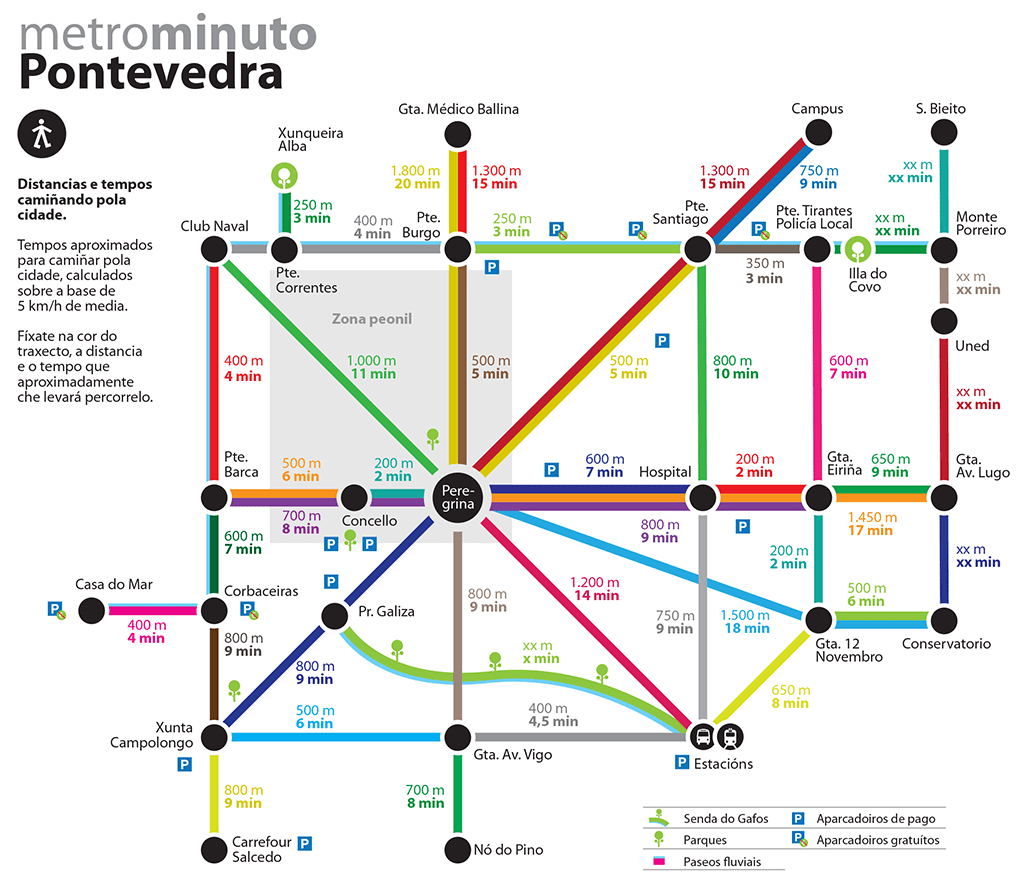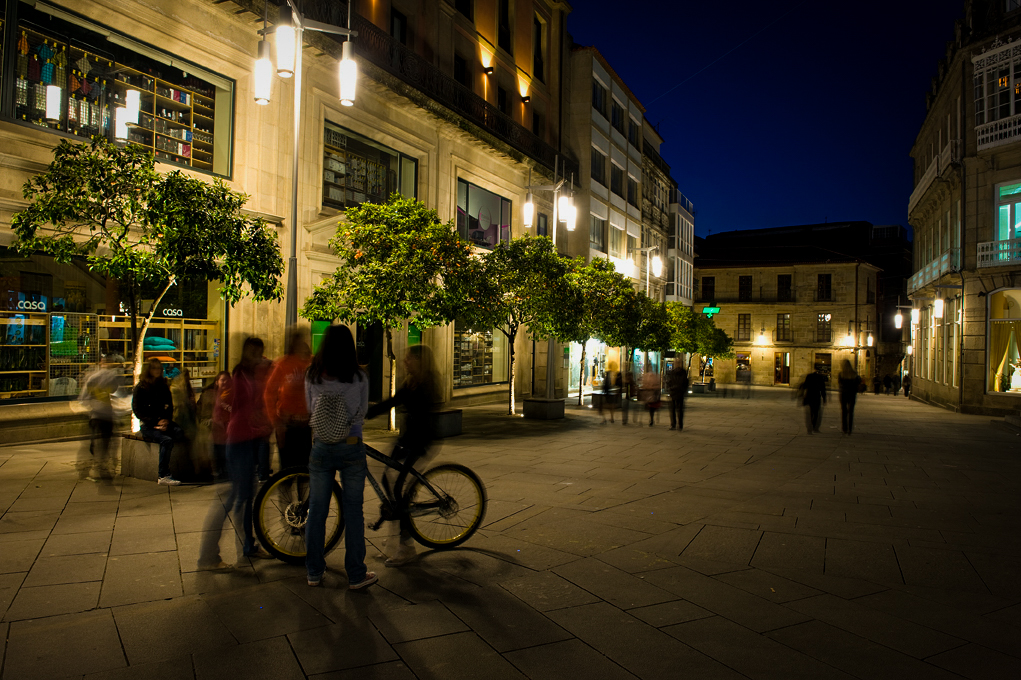The city of Pontevedra in the Northwest of Spain is recognised for its well-preserved old medieval town and beautiful cobbled streets. Yet the city has also gained world-wide attention for something entirely different – its urban mobility strategy which has turned its centre into an almost entirely car-free haven.
“Buying a Car Does Not Mean Buying Public Space”
Since Pontevedra first began its urban transformation over 20 years ago in 1999, it has left cities around the world in awe of its progress – going from car-choked to nearly car-free. It has been quite a turnaround: Before the now Mayor, Miguel Anxo Fernandez Lores, came to be in office, the city was in severe decline and excessively polluted.
We spoke to Xosé Cesareo Mosquera, the city’s head of infrastructures, to find out more about how Pontevedra went about making its changes: “It was a sad and stressed city, people felt like they had to escape to live on the outskirts.” The restoration that began at the turn of the century was one that completely remoulded the city into an international landmark in urban planning and sustainable mobility policies.
Lores’ philosophy throughout the process was simple:
“Owning a car does not give you the right to take up public space.”
Since then, Pontevedra has become globally recognised for its mobility renovations and has received several awards for its efforts including the UN-Habitat Award in 2014, the Intermodes Award in 2013 as well as the Active Design Award in 2015.
The Road to Car-Free: What Did Pontevedra Do?
How did this town with only 80,000 inhabitants manage to pull off an urban transformation in such a big way?
Within one month in office, Lores managed to pedestrianize 300,000 square meters of the city centre which stopped cars from crossing the city, and on-street car parking was removed on a large scale as planners realised people searching for parking spaces was what actually caused congestion.
They shut down surface level car parks which were replaced by underground ones and got rid of traffic lights in favour of roundabouts, in combination with traffic calming measures which helped to slow the traffic down to 30 km/hour. The city’s infrastructure was also strategically designed with wider sidewalks and narrower roads to encourage slower traffic, as well as strategically elevated pedestrian crossings to emphasize that vehicles are entering a pedestrian space.

These measures have helped not only infrastructurally but also to encourage a shift in people’s mindset more than anything to realise that cars are guests on the streets.
Lores admits that a transformation like this would be difficult to replicate with a bigger-scale city and that it would be hard to achieve the same results quickly – yet still, the city offers some useful ideas and inspiration on how to reduce traffic and deal with pollution.
The city’s pedestrian-centric ‘metrominuto’ model that shows the walking distances between the key points of the city, for example, is now a major trend in urban planning that has been transferred to other cities around the world.
What Have the Successes Been?
Since the changes were introduced the city has seen a colossal reduction in CO2 emissions of over 70%. In 2016 the municipal police of Pontevedra did not issue a single speeding ticket, and no fatal traffic accidents have been recorded since 2011.
The city also gained 12,000 new inhabitants who were drawn to the city’s newly restored and thriving centre, while over 2,000 school children between the ages of 6-12 can walk to class daily without fears of car traffic.
Each city will have to find its own model, says Lores, but Pontevedra is a real-life example that it is possible to reduce car-traffic and reap the benefits that come with it.
Is the ‘Pontevedra Formula’ Transferable?
While every city will be different, there are some things to keep in mind for other cities trying to follow in Pontevedra’s footsteps. Both Lores and Mosquera say that the model absolutely is transferable, but as Mosquera elaborated, “it need not be the only model, the city’s example should serve only as inspiration to others.”
Lores says that similar transformations can be carried out in cities with up to 180,000 inhabitants – but in larger cities, it could be experimented in ‘Pontevedra-like neighbourhoods’ instead of the whole city. This would mean that traffic is concentrated on the larger avenues of the metropolitan area so that around 80% of the streets are free of traffic.
Here’s how to get started with some key-takeaways of the city’s successful journey to car-free:
1. Don’t do things without a plan
Lores says that “when you simply remove parking without putting out street furniture or terraces or improving the space at all, then the person who cannot park their car there will be frustrated because it simply appears that nothing is being done with an area that could otherwise be used for parking. But when they see that the removed car parking has actually improved the area, by making it cleaner and a place where commerce grows with festive and cultural activity – this is how you win the support of the public.”
When converting car space, always have a plan for how to make more valuable use of the space.
Check out Pontevedra’s pedestrian strategy for more input.
2. Preservere for the majority
Talking about dealing with public backlash, Lores also told one Spanish news channel that “before tackling any pedestrianisation we organised an assembly with the neighbours. When you see headlines in the newspaper that ‘the local people are opposed to new measures’, you often find it is actually only 2 out of 200 neighbours who are critical.”
The ones that are the loudest very often just make up for a small percentage of the overall community – don’t just listen to the few complaining, give a voice to the majority, and persevere with new measures for the greater good.
3. Keep centres compact
Lores says that compact centres create sustainability. Therefore, any decisions in urban planning policy that aimed for city expansion always included the requirement for compactness.
City limits were moved outwards with new neighbourhoods and therefore districts have evolved in a manner that promotes commerce in their centres. Pontevedra has prevented sprawl by discouraging the construction of large shopping malls and rebuilding key landmarks such as the football stadium in its original location in the centre.
4. Don’t label it ‘car-free’
The mayor makes one point abundantly clear – the city of Pontevedra is not entirely car-free. “The point is that we only allow in the necessary vehicles – and this is the huge difference.” It shows people that the number of cars which are necessary for a city to function is a lot lower than believed.
Setting out to make an entirely car-free city is probably not a feasible idea and will generate a lot of backlash – but by simply allowing people to see that the “hierarchy of mobility priorities can be reversed” to put private vehicles at the bottom, this is really how you drive out cars.
5. Provide parking only on outer rings
Another thing that separates Pontevedra’s approach from other ‘car-free’ cities is that it still provides adequate parking for all vehicles coming from outside of the city on the outer rings with no cost or time limits.
This way, people are encouraged to ‘park and walk’, rather than drive right into the city centre where there are no through roads.
The Way Forward
In conclusion, Mosquera writes that the overall advice to a city going in the same direction as Pontevedra is that
“improving people’s lives is not an option – it is a duty, and we must be committed to doing it.”
Although small on the scale of cities, Pontevedra is a leading city when it comes to boldly removing cars and creating happier, more liveable urban spaces. Its progress has been unique and specific to the needs of the people living there, and this is exactly how cities inspired by the example of Pontevedra should go about: draft a tailor-made plan that fits their city’s needs and the needs of their citizens.



[…] and walkability. Pontevedra’s center, big compared to the city size as a whole, is completely walkable, a paradise for flanêurs interested in stone buildings and amiable tranquil respites as if one […]
[…] the sustainable revolution. Examples are Rwanda’s ban on plastic bags and the Spanish city, Pontevedra’s ban on vehicles from the city center. While no government can claim to be perfect, those that display authentic sustainability […]